The RNA recognition motif of eukaryotic translation initiation factor 3g (eIF3g) is required for resumption of scanning of posttermination ribosomes for reinitiation on GCN4 and together with eIF3i stimulates linear scanning
- PMID: 20679478
- PMCID: PMC2950517
- DOI: 10.1128/MCB.00430-10
The RNA recognition motif of eukaryotic translation initiation factor 3g (eIF3g) is required for resumption of scanning of posttermination ribosomes for reinitiation on GCN4 and together with eIF3i stimulates linear scanning
Abstract
Recent reports have begun unraveling the details of various roles of individual eukaryotic translation initiation factor 3 (eIF3) subunits in translation initiation. Here we describe functional characterization of two essential Saccharomyces cerevisiae eIF3 subunits, g/Tif35 and i/Tif34, previously suggested to be dispensable for formation of the 48S preinitiation complexes (PICs) in vitro. A triple-Ala substitution of conserved residues in the RRM of g/Tif35 (g/tif35-KLF) or a single-point mutation in the WD40 repeat 6 of i/Tif34 (i/tif34-Q258R) produces severe growth defects and decreases the rate of translation initiation in vivo without affecting the integrity of eIF3 and formation of the 43S PICs in vivo. Both mutations also diminish induction of GCN4 expression, which occurs upon starvation via reinitiation. Whereas g/tif35-KLF impedes resumption of scanning for downstream reinitiation by 40S ribosomes terminating at upstream open reading frame 1 (uORF1) in the GCN4 mRNA leader, i/tif34-Q258R prevents full GCN4 derepression by impairing the rate of scanning of posttermination 40S ribosomes moving downstream from uORF1. In addition, g/tif35-KLF reduces processivity of scanning through stable secondary structures, and g/Tif35 specifically interacts with Rps3 and Rps20 located near the ribosomal mRNA entry channel. Together these results implicate g/Tif35 and i/Tif34 in stimulation of linear scanning and, specifically in the case of g/Tif35, also in proper regulation of the GCN4 reinitiation mechanism.
Figures

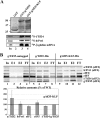
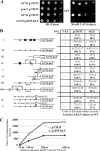
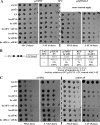

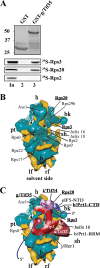
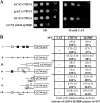

Similar articles
-
Ribosomal protein L33 is required for ribosome biogenesis, subunit joining, and repression of GCN4 translation.Mol Cell Biol. 2007 Sep;27(17):5968-85. doi: 10.1128/MCB.00019-07. Epub 2007 Jun 4. Mol Cell Biol. 2007. PMID: 17548477 Free PMC article.
-
eIF3a cooperates with sequences 5' of uORF1 to promote resumption of scanning by post-termination ribosomes for reinitiation on GCN4 mRNA.Genes Dev. 2008 Sep 1;22(17):2414-25. doi: 10.1101/gad.480508. Genes Dev. 2008. PMID: 18765792 Free PMC article.
-
Structural analysis of an eIF3 subcomplex reveals conserved interactions required for a stable and proper translation pre-initiation complex assembly.Nucleic Acids Res. 2012 Mar;40(5):2294-311. doi: 10.1093/nar/gkr765. Epub 2011 Nov 15. Nucleic Acids Res. 2012. PMID: 22090426 Free PMC article.
-
Does eIF3 promote reinitiation after translation of short upstream ORFs also in mammalian cells?RNA Biol. 2017 Dec 2;14(12):1660-1667. doi: 10.1080/15476286.2017.1353863. Epub 2017 Sep 15. RNA Biol. 2017. PMID: 28745933 Free PMC article. Review.
-
Gene-specific translational control of the yeast GCN4 gene by phosphorylation of eukaryotic initiation factor 2.Mol Microbiol. 1993 Oct;10(2):215-23. doi: 10.1111/j.1365-2958.1993.tb01947.x. Mol Microbiol. 1993. PMID: 7934812 Review.
Cited by
-
The eIF3c/NIP1 PCI domain interacts with RNA and RACK1/ASC1 and promotes assembly of translation preinitiation complexes.Nucleic Acids Res. 2012 Mar;40(6):2683-99. doi: 10.1093/nar/gkr1083. Epub 2011 Nov 28. Nucleic Acids Res. 2012. PMID: 22123745 Free PMC article.
-
Phosphorylation of a reinitiation supporting protein, RISP, determines its function in translation reinitiation.Nucleic Acids Res. 2021 Jul 9;49(12):6908-6924. doi: 10.1093/nar/gkab501. Nucleic Acids Res. 2021. PMID: 34133725 Free PMC article.
-
An mRNA-binding channel in the ES6S region of the translation 48S-PIC promotes RNA unwinding and scanning.Elife. 2019 Dec 2;8:e48246. doi: 10.7554/eLife.48246. Elife. 2019. PMID: 31789591 Free PMC article.
-
Molecular mechanism of scanning and start codon selection in eukaryotes.Microbiol Mol Biol Rev. 2011 Sep;75(3):434-67, first page of table of contents. doi: 10.1128/MMBR.00008-11. Microbiol Mol Biol Rev. 2011. PMID: 21885680 Free PMC article. Review.
-
Human eIF3b and eIF3a serve as the nucleation core for the assembly of eIF3 into two interconnected modules: the yeast-like core and the octamer.Nucleic Acids Res. 2016 Dec 15;44(22):10772-10788. doi: 10.1093/nar/gkw972. Epub 2016 Oct 19. Nucleic Acids Res. 2016. PMID: 27924037 Free PMC article.
References
-
- Ahlemann, M., R. Zeidler, S. Lang, B. Mack, M. Münz, and O. Gires. 2006. Carcinoma-associated eIF3i overexpression facilitates mTOR-dependent growth transformation. Mol. Carcinog. 45:957-967. - PubMed
-
- Asano, K., L. Phan, J. Anderson, and A. G. Hinnebusch. 1998. Complex formation by all five homologues of mammalian translation initiation factor 3 subunits from yeast Saccharomyces cerevisiae. J. Biol. Chem. 273:18573-18585. - PubMed
-
- Asano, K., H.-P. Vornlocher, N. J. Richter-Cook, W. C. Merrick, A. G. Hinnebusch, and J. W. B. Hershey. 1997. Structure of cDNAs encoding human eukaryotic initiation factor 3 subunits: possible roles in RNA binding and macromolecular assembly. J. Biol. Chem. 272:27042-27052. - PubMed
-
- Berthelot, K., M. Muldoon, L. Rajkowitsch, J. Hughes, and J. E. G. McCarthy. 2004. Dynamics and processivity of 40S ribosome scanning on mRNA in yeast. Mol. Microbiol. 51:987-1001. - PubMed
Publication types
MeSH terms
Substances
Grants and funding
LinkOut - more resources
Full Text Sources
Molecular Biology Databases
Miscellaneous
